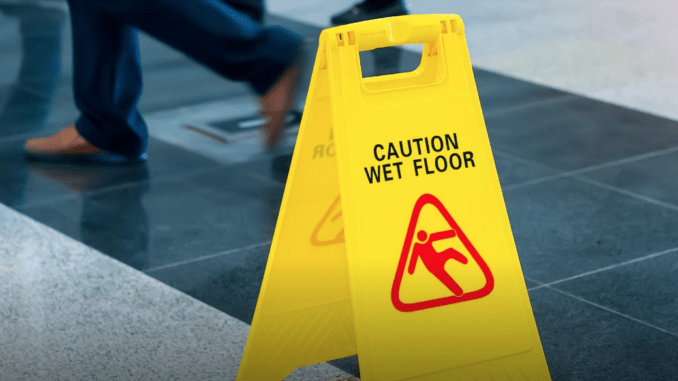
As more employees return to the workplace, especially warehouses, health and safety precautions are increasingly important. Dealers can help ensure employers do all they can to keep workers safe
Accidents in the workplace are still a common occurrence – there were 582,000 in 2018/19 according to the Health and Safety Executive – and, as more people return to the workplace, health and safety precautions are high on employers’ agendas.
This is especially so in warehouses, which are often busy places and also potentially dangerous. There is a lot going on – the use of heavy equipment, forklift trucks being driven about, high warehouse racking – all of which can be potentially hazardous.
With the end of social distancing a lot of people are going back into warehouses at the same time – people who may have forgotten the health and safety practices they followed before. These messages need to be reinforced to minimise the chances of accidents, which can be costly for both the injured worker and the business in terms of potential fines – and dealers can play an important role in this.
SEEING THE SIGNS
One of the most basic, yet effective, pieces of safety equipment is signage. “Prohibitive signs are common in warehouses. These red signs grab attention and inform what can and can’t be done in those areas,” says Peter Clayton, head of sales at Spectrum Industrial. “While prohibitive signs aim to stop people from doing a specific action in the warehouse, mandatory signs show what you need to do, or what action is required in a specific area such as ‘High visibility clothing must be worn’.
“Hazard warning signs are designed to protect, and warn everyone from the possible dangers of a specific area or machinery – very beneficial signage if people are unaware of any potential hazards in a particular part of the warehouse.”
Peter adds that floor graphics play an important role in warehouses. There is often limited wall space available anyway but, as people tend to look down while they are walking around a warehouse, a floor graphic
can be a very effective option. “As well as the types of signage positioned as wall graphics, line markings also help to define the safe walkways around a warehouse. When it comes to safety in the warehouse you will find a combination of safety signs that act as both warnings as well as safety measures in relevant areas help to keep warehouse workers safe.”
Of course, visual signage involves more than just warnings or prohibitors; it can also act as a reminder, especially for maintaining hygiene, which is still important as COVID-19 continues to be a threat in the workplace. “Hand hygiene is always going to be prevalent following the pandemic,” says Steph Gentle from Beaverswood. “The need for social distancing type products has reduced, but warehouses are busier now, so companies have to invest more in the safety and comfort of their employees.
“This is where safety signage and visual communication is key. Visual cues, which can be anything from coloured frames to shadowboards, help with maintaining hygiene in the workplace as they ensure the right cleaning equipment goes back to the right area. Shadowboards can also provide first aid and biosafety stations. We are seeing greater demand for these sorts of products; anything that makes the warehouse more organised means productivity is higher, and employees are safer.”
Along similar lines, things like rack end barriers and rack protection equipment are also seeing growth in demand, adds Steph. Outside the warehouse too, there are opportunities for dealers, with demand for things like bollards and delineator posts growing. “Safety onsite is key, but space is also at a premium as floor space is hard to come by and every square metre counts,” says Steph. “Innovative solutions such as rack end boards – rack ends are usually a dead space – where you can house a health and safety station, or a communication board – can be important for customers.”
FIRST AID
While warnings and safety equipment are important, accidents still happen – as the statistics attest – so first aid provision is vital. “Businesses care about their employees – they want them to feel safe at work,” says Adam Weidenbaum, commercial group director for Safety First Aid Group Ltd. “There is a greater appreciation now of the importance of comprehensive first aid provisions, from first aid kits to defibrillators.”
The requirements for first aid provision are partially determined by the number of people employed and the level of risk involved in the work, Adam explains. “Site size and layout can also be important factors, particularly on larger sites. If there is a long walk from one side of the site to the other, or if there are multiple floors, more first aid kits will be required.
“Visibility is key where first aid supplies may need to be spotted from a distance. Brightly coloured, wall-mounted, first aid stations are the perfect solution for larger environments. Posters and signage also help to increase awareness of first aid and safety, emphasising to employees that their well-being is paramount. In workplaces with a lot of temporary workers, this becomes an essential part of maintaining safety protocols and ensuring appropriate action is taken in emergencies.
“Additional supplies may be required, depending on the nature of the work. Many warehouses stock extra eye wash, as dust particles are a risk; similarly, trauma kits are often kept in workplaces where there is frequent use of machinery, such as forklifts and pallet trucks.”
While warehousing is a sector that many dealers are still just getting into, there are plenty of opportunities available in the sale of health and safety equipment and signage. Employers appreciate its importance, and many will be looking to implement more measures as increasing numbers of people come back into the workplace or sites expand. Make sure you are there to help and advise.


Be the first to comment